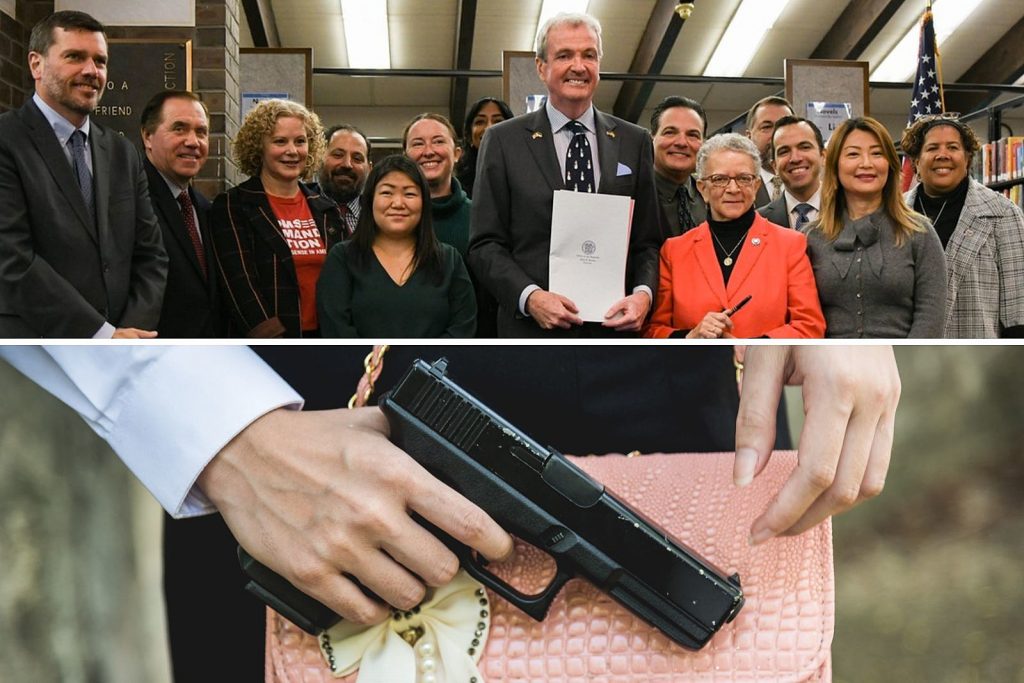A Federal Judge Blocks New Jersey’s Sweeping Restrictions on Public Gun Possession

Last June inNew York State Rifle & Pistol Association v. Bruen, the Supreme Court held that states may not require gun owners to “demonstrate a special need for self-protection distinguishable from that of the general community” before they can exercise the constitutional right to bear arms. New York legislators responded by eliminating the state’s “proper cause” requirement for carry permits but simultaneously making those permits much less useful by declaring them inoperative in a long list of “sensitive locations.”
That attempted end run aroundBruen soon ran into legal trouble, including a temporary restraining order that U.S. District Judge Glenn T. Suddaby issued in October, which was followed by a preliminary injunction in November. Unfazed by those warnings, New Jersey legislators emulated New York’s approach with a bill that Gov. Phil Murphy signed into law last month. The law abolished the state’s “justifiable need” requirement for a carry permit but made it very difficult for permit holders to legally carry handguns outside their homes. Last week that trick predictably provoked a temporary restraining order.
“The State may regulate conduct squarely protected by the Second Amendment only if supported by a historical tradition of firearm regulation,” U.S. District Judge Rene Marie Bumb writes in her January 9 opinion. “Plaintiffs have shown that Defendants will not be able to demonstrate a history of firearm regulation to support any of the challenged provisions.”
New Jersey decreed that permit holders may not carry handguns in 25 categories of “sensitive places.” Violating those rules is a third-degree crime punishable by up to five years in prison.
Three permit holders, joined by the Firearms Policy Coalition and other gun rights groups, challenged the state’s new restrictions in Koons v. Reynolds. Bumb’s opinion deals with four of New Jersey’s gun-free zones: libraries and museums, entertainment facilities, businesses that serve alcohol, and “private property” generally unless the owner has given his express consent or posted a sign indicating that guns are allowed. Bumb also addresses New Jersey’s ban on the transportation of loaded or accessible firearms in private vehicles. She concludes that the state so far has failed to show that any of those rules is “consistent with the Nation’s historical tradition of firearm regulation,” the test established by Bruen.
That tradition, the Supreme Court has said, includes “laws forbidding the carrying of firearms in sensitive places such as schools and government buildings.” But inBruen, the Court warned against defining “sensitive places” so broadly that they encompass nearly every location where a permit holder might want to carry a handgun for self-defense.
“The historical record yields relatively few 18th- and 19th-century ‘sensitive places’ where weapons were altogether prohibited,” the Court noted, mentioning “legislative assemblies, polling places, and courthouses.” The majority rejected New York’s attempt to cast its “proper cause” requirement as a kind of “sensitive place” regulation. New York argued that the right to bear arms does not apply in “places where people typically congregate and where law-enforcement and other public-safety professionals are presumptively available.”
That rationale, the Court noted, “would in effect exempt cities from the Second Amendment and would eviscerate the general right to publicly carry arms for self-defense.” It said “there is no historical basis for New York to effectively declare the island of Manhattan a ‘sensitive place’ simply because it is crowded and
protected generally by the New York City Police Department.”
New Jersey’s law attempts to achieve a similar result. The legislature averred that “sensitive-place prohibitions on dangerous weapons set forth in this act are rooted in history and tradition” because they are “analogous to historical laws that can
be found from the Founding era to Reconstruction.” Yet when required to present that evidence in Koons v. Reynolds, the state came up short, saying it has not had enough time to identify relevant historical analogs.
“At this juncture,” Bumb says, “there is no bona fide basis for this Court to withhold its ruling because the State says it needs more time to come forward with historical evidence that the Legislature represented it had at the time of the law’s passage.” The evidence at this point, she concludes, is meager, inapposite, or both.
A few examples should suffice to show how ill-prepared the state was to defend its understanding of “sensitive places.”
New Jersey’s law prohibits guns in any “privately or publicly owned and operated entertainment facility,” “including but not limited to a theater, stadium, museum, arena, racetrack or other place where performances, concerts, exhibits, games or contests are held.” The state compared that ban to a 1786 Virginia law that prohibited carrying arms in “fairs or markets, in terror of the county.” As Bumb notes, “it is the conduct of terrorizing the county, not the possession of a firearm in fairs or markets, that the statute prohibited.”
The state defended its ban on guns in bars and restaurants by citing an 1867 Kansas law that “prohibited the possession of firearms by intoxicated persons.” That law “has no relevance here,” Bumb notes, “as the restriction at issue clearly does not address possession of firearms by intoxicated persons.”
The broadest location restriction, covering most places in the state, established a default rule that guns are prohibited on “private property,” the same rule that federal judges rejected in New York. Like New York, New Jersey claimed it was merely protecting the prerogatives of private property owners, who have always had a right to exclude guns. But the law changed a presumption that people have a right to carry guns in businesses open to the public unless the owner objects to a presumption that they have no such right unless the owner explicitly says guns are allowed by posting “clear and conspicuous signage” or otherwise giving “express consent.”
Bumb says the historical evidence indicates that the first presumption has long prevailed in the United States. “Defendants’ insistence that no such presumption exists because a private property owner has the right to exclude firearms from his property misses the point,” she writes. “Here, the State itself, not a private property owner, is excluding firearm owners from most of New Jersey by default.”
The state said the new rule “protects property owners’ right to exclude firearms from their property by removing their obligation to affirmatively tell every repairperson or customer that firearms are prohibited” (emphasis added). That argument, Bumb says, only confirms that “a rebuttable presumption to carry” was the preexisting rule. She “agrees with Plaintiffs, at least at this stage, that this provision unconstitutionally turns the presumption of the right to keep and bear arms under the Second Amendment on its head.”
During oral argument, Bumb called attention to the quandaries that New Jersey’s law creates for permit holders. She asked New Jersey Deputy Solicitor General Angela Cai whether a UPS employee licensed to carry a handgun would “violate the law when he gets up to the front door and the owner says you should not have come on my property if you’re armed.” Yes, Cai replied. In other words, permit holders are committing a crime punishable by up to five years in prison even before they find out that a customer or business owner does not want guns on his property.
When you combine that default rule with the location-specific bans and the restrictions on guns in cars, which require that they be kept unloaded in the trunk or a “securely fastened” container, you have scenarios like this one, which Bumb also described during oral argument: Someone with a concealed carry permit wakes up and plans his day…He puts the firearm in the trunk. He goes to his cousin, who doesn’t want firearms. He leaves it in the trunk. He then goes to the local market that permits firearms. He goes and he ges [the gun] out of the trunk, puts it together in public view. Citizens see. Citizens are going to get alarmed. Perhaps he’s brandishing the weapon [a distinct crime], one might argue. And then [he] goes to the local market. Then he comes back out. He then brandishes the weapon, one could argue, puts it into the trunk and goes to another establishment where he’s not quite sure, so he puts it in the trunk and then goes up, gets the express consent, yes, that’s fine, goes back to his trunk…assembles the firearm and then…reenters the property.
That’s how the State envisions the day in the life of a gun owner?
Pretty much. “That could be, Your Honor,” Cai conceded.
That situation seems plainly inconsistent with the right to bear arms. “As Plaintiffs lament, the challenged provisions force a person permitted to carry a firearm in New Jersey to ‘navigate a “veritable minefield,”‘” Bumb writes. “At some point on the line, when a constitutional right becomes so burdensome or unwieldy to exercise, it is, in effect, no longer a constitutional right. Plaintiffs have made a convincing case that this legislation has reached that point.”




